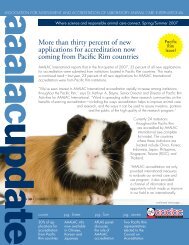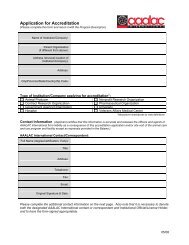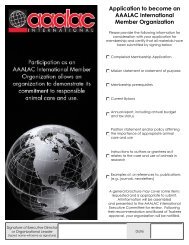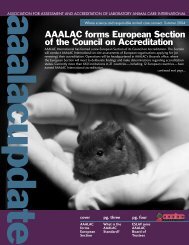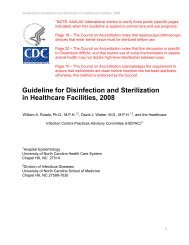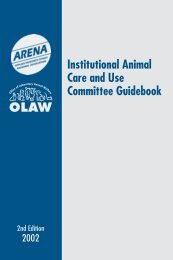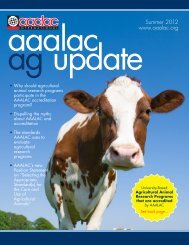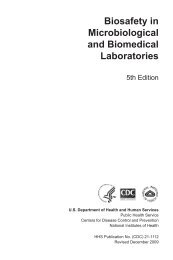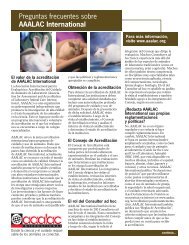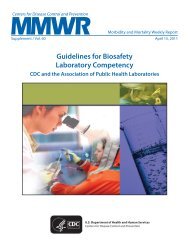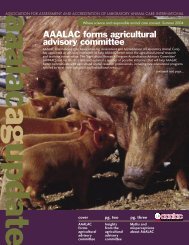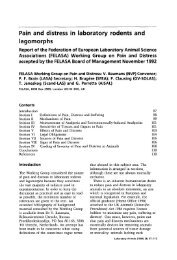Chapter 3: Husb<strong>and</strong>ry, Hous<strong>in</strong>g, <strong>and</strong> BiosecurityProper management is essential <strong>for</strong> <strong>the</strong> well-be<strong>in</strong>g<strong>of</strong> <strong>the</strong> animals, <strong>the</strong> validity <strong>and</strong> effectiveness <strong>of</strong>research <strong>and</strong> teach<strong>in</strong>g activities, <strong>and</strong> <strong>the</strong> health<strong>and</strong> safety <strong>of</strong> animal care personnel. Sound animal husb<strong>and</strong>ryprograms provide systems <strong>of</strong> care that permit<strong>the</strong> animals to grow, mature, reproduce, <strong>and</strong> be healthy.Specific operat<strong>in</strong>g procedures depend on many factorsthat are unique to <strong>in</strong>dividual <strong>in</strong>stitutions. Well-tra<strong>in</strong>ed<strong>and</strong> properly motivated personnel can <strong>of</strong>ten achievehigh quality animal care with less than ideal physicalplants <strong>and</strong> equipment.FACILITIES AND ENVIRONMENTEnvironmental Requirements <strong>and</strong> StressDomestic animals are relatively adaptable to a widerange <strong>of</strong> environments (Hale, 1969; Craig, 1981; Soss<strong>in</strong>ka,1982; Curtis, 1983; Price, 1984, 1987; Fraser,1985; Yousef, 1985a,b,c). Domestication is a cont<strong>in</strong>u<strong>in</strong>gprocess. Genetic stra<strong>in</strong>s <strong>of</strong> animals selected <strong>for</strong> growthor reproduction <strong>in</strong> different environments under vary<strong>in</strong>gdegrees <strong>of</strong> control are used currently <strong>for</strong> much <strong>of</strong><strong>the</strong> production <strong>of</strong> livestock <strong>and</strong> poultry (Siegel, 1995).These stra<strong>in</strong>s <strong>of</strong> animals are sometimes very differentfrom <strong>the</strong> breeds or stra<strong>in</strong>s from which <strong>the</strong>y were orig<strong>in</strong>allyderived (Ollivier, 1988; Craig, 1994; Havenste<strong>in</strong>et al., 1994a,b). <strong>Agricultural</strong> animals may be kept <strong>in</strong>extensive environments (e.g., pasture or range) where<strong>the</strong>y reside <strong>in</strong> large areas (e.g., acres or square miles)outdoors. They may also be kept <strong>in</strong> <strong>in</strong>tensive environments(e.g., <strong>in</strong> houses, pens, or cages) where <strong>the</strong>y areconf<strong>in</strong>ed to an area that would not susta<strong>in</strong> <strong>the</strong>m were<strong>the</strong> environment not controlled <strong>and</strong> where food, water,<strong>and</strong> o<strong>the</strong>r needs must be provided to <strong>the</strong>m. Individualanimals may be moved dur<strong>in</strong>g <strong>the</strong>ir lives from extensiveto <strong>in</strong>tensive systems or vice versa. Species requirements<strong>for</strong> domesticated animals are thus variable <strong>and</strong>depend both on <strong>the</strong> genetic background <strong>of</strong> <strong>the</strong> animals<strong>and</strong> <strong>the</strong>ir prior experience.Criteria <strong>of</strong> Well-Be<strong>in</strong>gVarious criteria have been proposed to identify <strong>in</strong>appropriatemanagement <strong>and</strong> hous<strong>in</strong>g conditions <strong>for</strong> agriculturalanimals. For example, <strong>in</strong> poultry, significantfea<strong>the</strong>r loss that is not associated with natural mat<strong>in</strong>gor natural molt<strong>in</strong>g is widely accepted as an <strong>in</strong>dicationthat birds are experienc<strong>in</strong>g stressful conditions. Moresophisticated measures <strong>of</strong> stress are not necessarily superior<strong>and</strong> may even yield confus<strong>in</strong>g results <strong>and</strong> lead to<strong>in</strong>accurate conclusions (Moberg, 1985; Rushen, 1991;Rodenburg <strong>and</strong> Koene, 2004). For <strong>in</strong>stance, plasma corticosteroidconcentrations <strong>of</strong> hens resid<strong>in</strong>g <strong>in</strong> spaciousfloor pens may be similar to those <strong>in</strong> high-density cages,even though o<strong>the</strong>r criteria may <strong>in</strong>dicate that <strong>the</strong> cagedhens are adversely affected by <strong>the</strong>ir environment (Craig<strong>and</strong> Craig, 1985; Craig et al., 1986). Dur<strong>in</strong>g stressfulsocial situations, resistance to virus-<strong>in</strong>duced diseasesmay be depressed, but resistance to bacterial <strong>in</strong>fections<strong>and</strong> parasites may be <strong>in</strong>creased (Siegel, 1980; Gross <strong>and</strong>Siegel, 1983, 1985).Some researchers have placed emphasis on behavioralcriteria <strong>of</strong> well-be<strong>in</strong>g (Wood-Gush et al., 1975),although o<strong>the</strong>rs have po<strong>in</strong>ted out <strong>the</strong> difficulties <strong>of</strong><strong>in</strong>terpretation <strong>in</strong>volved (Duncan, 1981; Craig <strong>and</strong> Adams,1984; Dawk<strong>in</strong>s, 1990). In <strong>the</strong> same way, some researchers(Craig <strong>and</strong> Adams, 1984) have suggested thatdepressed per<strong>for</strong>mance <strong>of</strong> <strong>in</strong>dividuals, <strong>in</strong>dependent <strong>of</strong>economic considerations, is a relatively sensitive reflector<strong>of</strong> chronic stressors, but Hill (1983) was less conv<strong>in</strong>cedus<strong>in</strong>g <strong>the</strong> same parameters.Animal well-be<strong>in</strong>g has both physical <strong>and</strong> psychologicalcomponents (Fraser <strong>and</strong> Broom, 1990; Duncan, 1993;Fraser, 1993). No s<strong>in</strong>gle objective measurement existsthat can be used to evaluate <strong>the</strong> level <strong>of</strong> well-be<strong>in</strong>g associatedwith a particular system <strong>of</strong> agricultural animalproduction. There is consensus, however, that multiple<strong>in</strong>tegrated <strong>in</strong>dicators provide <strong>the</strong> best means <strong>of</strong> assess<strong>in</strong>gwell-be<strong>in</strong>g (Curtis, 1982; Mench <strong>and</strong> van Tienhoven,1986; Rushen <strong>and</strong> de Passillé, 1992; Mason <strong>and</strong> Mendl,1993; Mitlöhner et al., 2001). Indicators <strong>in</strong> 4 catego-16
ies are generally advocated: 1) behavior patterns; 2)pathological <strong>and</strong> immunological traits; 3) physiological<strong>and</strong> biochemical characteristics; <strong>and</strong> 4) reproductive<strong>and</strong> productive per<strong>for</strong>mance <strong>of</strong> <strong>the</strong> <strong>in</strong>dividual animal.A judgment as to <strong>the</strong> balance <strong>of</strong> evidence provided by<strong>the</strong>se <strong>in</strong>dicators has been used, when available, as <strong>the</strong>basis <strong>for</strong> <strong>the</strong> recommendations <strong>in</strong> this guide.D. C. Hardwick postulated (cited <strong>in</strong> Duncan, 1978)<strong>and</strong> Duncan (1978) developed <strong>the</strong> idea that an acceptablelevel <strong>of</strong> animal welfare exists over a range <strong>of</strong> conditionsprovided by a variety <strong>of</strong> agricultural productionsystems, not under just one ideal set <strong>of</strong> circumstances.Improvements <strong>in</strong> certa<strong>in</strong> environments may <strong>in</strong>creaseanimal well-be<strong>in</strong>g somewhat, but any po<strong>in</strong>t <strong>in</strong> <strong>the</strong> rangewould still be considered acceptable with respect to animalwelfare. Good management <strong>and</strong> a high st<strong>and</strong>ard<strong>of</strong> stockmanship are important <strong>in</strong> determ<strong>in</strong><strong>in</strong>g <strong>the</strong> acceptability<strong>of</strong> a particular production system (Hurnik,1988) <strong>and</strong> should be emphasized <strong>in</strong> agricultural animalresearch <strong>and</strong> teach<strong>in</strong>g facilities.Macroenvironment <strong>and</strong> MicroenvironmentAnimal well-be<strong>in</strong>g is a function <strong>of</strong> many environmentalvariables, <strong>in</strong>clud<strong>in</strong>g physical surround<strong>in</strong>gs, nutritional<strong>in</strong>take, <strong>and</strong> social <strong>and</strong> biological <strong>in</strong>teractions(Hafez, 1968; Curtis, 1983; Yousef, 1985a). Environmentalconditions should be such that stress, illness,mortality, <strong>in</strong>jury, <strong>and</strong> behavioral problems are m<strong>in</strong>imized.Particular components <strong>of</strong> <strong>the</strong> environment thatneed to be taken <strong>in</strong>to account <strong>in</strong>clude temperature, humidity,light, air quality, space (<strong>in</strong>clud<strong>in</strong>g complexity<strong>of</strong> space), social <strong>in</strong>teractions, microbe concentrations,noise, verm<strong>in</strong> <strong>and</strong> predators, nutritional factors, <strong>and</strong>water. See Chapter 4: Environmental Enrichment <strong>for</strong>fur<strong>the</strong>r <strong>in</strong><strong>for</strong>mationPhysical conditions <strong>in</strong> <strong>the</strong> room, house, barn, or outsideenvironment constitute <strong>the</strong> macroenvironment; <strong>the</strong>microenvironment <strong>in</strong>cludes <strong>the</strong> immediate physical <strong>and</strong>biological surround<strong>in</strong>gs. Different microenvironmentsmay exist with<strong>in</strong> <strong>the</strong> same macroenvironment. Bothmicroenvironment <strong>and</strong> macroenvironment should beappropriate <strong>for</strong> <strong>the</strong> genetic background <strong>and</strong> age <strong>of</strong> <strong>the</strong>animals <strong>and</strong> <strong>the</strong> purpose <strong>for</strong> which <strong>the</strong>y are be<strong>in</strong>g used.Domestic animals readily adapt to a wide range <strong>of</strong> environments,but some genetic stra<strong>in</strong>s have specific needs<strong>of</strong> which <strong>the</strong> scientist should be aware <strong>and</strong> <strong>for</strong> whichaccommodation should be made.Even <strong>in</strong> relatively moderate climatic regions, wea<strong>the</strong>revents such as floods, w<strong>in</strong>ter storms, <strong>and</strong> summer heatwaves may require that animals have access to shelter.If trees or geographic features do not provide enoughprotection, artificial shelters <strong>and</strong> (or) w<strong>in</strong>dbreaks orsunshades should be provided (Mitlöhner et al., 2001,2002; Johnson et al., 2008; Marcillac-Embertson et al.,2009).HUSBANDRY, HOUSING, AND BIOSECURITYGenetic DifferencesSome stra<strong>in</strong>s <strong>of</strong> agricultural animals may have requirementsthat differ substantially from those <strong>of</strong> o<strong>the</strong>rstocks <strong>of</strong> <strong>the</strong> same species (Gross et al., 1984). Somestra<strong>in</strong>s <strong>of</strong> pigs, <strong>for</strong> example, are particularly susceptibleto stress because <strong>the</strong>y carry a gene that causes malignanthyper<strong>the</strong>rmia when <strong>the</strong>y experience even mildstress (Bäckström <strong>and</strong> Kauffman, 1995). Transgenicanimals may also have special needs <strong>for</strong> husb<strong>and</strong>ry <strong>and</strong>care (Mench, 1998). Practices to ensure <strong>the</strong> well-be<strong>in</strong>g<strong>of</strong> special stra<strong>in</strong>s should be established <strong>in</strong>dependently <strong>of</strong>those made <strong>for</strong> <strong>the</strong> species <strong>in</strong> general. Refer to Chapter4: Environmental Enrichment <strong>for</strong> more detailed <strong>in</strong><strong>for</strong>mationon enhancement <strong>of</strong> animals’ physical or socialenvironments.Space RequirementsFloor area is only one <strong>of</strong> <strong>the</strong> components that determ<strong>in</strong>e<strong>the</strong> space requirements <strong>of</strong> an animal. Enclosureshape, floor type, ceil<strong>in</strong>g height, location <strong>and</strong> dimensions<strong>of</strong> feeders <strong>and</strong> waterers, features <strong>in</strong>side <strong>the</strong> enclosure,<strong>and</strong> o<strong>the</strong>r physical <strong>and</strong> social elements affect<strong>the</strong> amount <strong>of</strong> space sensed, perceived, <strong>and</strong> used by<strong>the</strong> animals <strong>in</strong> <strong>in</strong>tensive management systems (Strickl<strong>and</strong>et al., 1979; Strickl<strong>and</strong> <strong>and</strong> Gonyou, 1995). Whenpossible, animals <strong>in</strong> stanchions, cages, crates, or stallsshould be allowed to view one ano<strong>the</strong>r, animal carepersonnel, <strong>and</strong> o<strong>the</strong>r activities where this would not<strong>in</strong>terfere with research or teach<strong>in</strong>g objectives.Determ<strong>in</strong>ation <strong>of</strong> area requirements <strong>for</strong> domestic animalsshould be based on body size, head height, stage<strong>of</strong> life cycle, behavior, health, <strong>and</strong> wea<strong>the</strong>r conditions.All area recommendations <strong>in</strong> this guide refer to <strong>the</strong>animal zone (i.e., <strong>the</strong> space that can be used by <strong>the</strong>animal). Unless experimental or welfare considerationsdictate o<strong>the</strong>rwise, space should be sufficient <strong>for</strong> normalpostural adjustments, <strong>in</strong>clud<strong>in</strong>g st<strong>and</strong><strong>in</strong>g, ly<strong>in</strong>g, rest<strong>in</strong>g,self-groom<strong>in</strong>g, eat<strong>in</strong>g, dr<strong>in</strong>k<strong>in</strong>g, <strong>and</strong> elim<strong>in</strong>at<strong>in</strong>g feces<strong>and</strong> ur<strong>in</strong>e. When animals are crowded, body weightga<strong>in</strong> <strong>and</strong> o<strong>the</strong>r per<strong>for</strong>mance traits may be depressed(Gehlbach et al., 1966; Adams <strong>and</strong> Craig, 1985), <strong>and</strong><strong>the</strong> animals may show altered levels <strong>of</strong> aggressive behavior(Bryant <strong>and</strong> Ewbank, 1974; Al-Rawi <strong>and</strong> Craig,1975).Temperature, Water Vapor Pressure, <strong>and</strong>VentilationAir temperature, water vapor pressure, <strong>and</strong> air velocityare some <strong>of</strong> <strong>the</strong> most important factors <strong>in</strong> <strong>the</strong>physical environment <strong>of</strong> agricultural animals. In addition,factors related to animal health (i.e., <strong>in</strong>fectiousstatus) <strong>and</strong> genetics (i.e., trangenic modification) affect<strong>the</strong> <strong>the</strong>rmal balance <strong>of</strong> animals <strong>and</strong> thus <strong>the</strong>ir behavior,metabolism, <strong>and</strong> per<strong>for</strong>mance.17
- Page 1 and 2: Guide for the Care and Useof Agricu
- Page 3 and 4: Guide Revision Committees for the F
- Page 5 and 6: Chapter 6: Beef Cattle 61Facilities
- Page 7: PrefaceThis is the third edition of
- Page 10 and 11: 2 CHAPTER 1The IACUC should meet at
- Page 12 and 13: 4 CHAPTER 1tion Center at the Natio
- Page 14 and 15: 6 CHAPTER 1Disposition of Animal Cl
- Page 16 and 17: Chapter 2: Agricultural Animal Heal
- Page 18 and 19: 10 CHAPTER 2and behavioral health e
- Page 20 and 21: 12 CHAPTER 2care attendants or rese
- Page 22 and 23: 14 CHAPTER 2exposed to these chemic
- Page 26 and 27: 18 CHAPTER 3Most agricultural anima
- Page 28 and 29: 20 CHAPTER 3gases, particulates, an
- Page 30 and 31: 22 CHAPTER 3in pairs or groups when
- Page 32 and 33: 24 CHAPTER 3screened with 1.3-cm (0
- Page 34 and 35: 26 CHAPTER 3priate, and institution
- Page 36 and 37: 28 CHAPTER 3ings and Deliberations.
- Page 38 and 39: Chapter 4: Environmental Enrichment
- Page 40 and 41: 32 CHAPTER 4(Feh and de Mazieres, 1
- Page 42 and 43: 34 CHAPTER 4Substrate: The provisio
- Page 44 and 45: 36 CHAPTER 4mize regrouping and soc
- Page 46 and 47: 38 CHAPTER 4not especially attracte
- Page 48 and 49: 40 CHAPTER 4Croney, C. C., K. M. Ad
- Page 50 and 51: 42 CHAPTER 4Meunier-Salaün, M. C.,
- Page 52 and 53: 44 CHAPTER 4Wilson, S. C., F. M. Mi
- Page 54 and 55: 46 CHAPTER 5dling facility in the f
- Page 56 and 57: 48 CHAPTER 5Table 5-1. Visual distr
- Page 58 and 59: 50 CHAPTER 5Animals should be handl
- Page 60 and 61: 52 CHAPTER 5be given during conditi
- Page 62 and 63: 54 CHAPTER 5mercial broiler farms,
- Page 64 and 65: 56 CHAPTER 5The condition of the an
- Page 66 and 67: 58 CHAPTER 5Arnold, G. W. 1977. An
- Page 68 and 69: 60 CHAPTER 5for veterinary and husb
- Page 70 and 71: 62 CHAPTER 6managers of confined ca
- Page 72 and 73: 64 CHAPTER 6Cold housing can be pro
- Page 74 and 75:
66 CHAPTER 6HUSBANDRYAdequate care
- Page 76 and 77:
68 CHAPTER 6ately to perform a caes
- Page 78 and 79:
70 CHAPTER 6minimum amount of time
- Page 80 and 81:
72 CHAPTER 6Ensminger, M. E. 1970.
- Page 82 and 83:
Chapter 7: Dairy CattleDairy cattle
- Page 84 and 85:
76 CHAPTER 7Table 7-1. Recommended
- Page 86 and 87:
78 CHAPTER 7ties should be provided
- Page 88 and 89:
80 CHAPTER 7quent feeding, and exce
- Page 90 and 91:
82 CHAPTER 7hanced sensitivity to h
- Page 92 and 93:
84 CHAPTER 7effective for removing
- Page 94 and 95:
86 CHAPTER 7Albright, J. L. 1978. S
- Page 96 and 97:
88 CHAPTER 7Murphy, M. R., C. L. Da
- Page 98 and 99:
Chapter 8: HorsesMost horses are us
- Page 100 and 101:
92 CHAPTER 8Temperature and Ventila
- Page 102 and 103:
94 CHAPTER 8tritional programs for
- Page 104 and 105:
96 CHAPTER 8WaterClean water should
- Page 106 and 107:
98 CHAPTER 8bots (Gastrophilus inte
- Page 108 and 109:
100 CHAPTER 8STANDARD AGRICULTURALP
- Page 110 and 111:
102 CHAPTER 8of Animals. C. McGowan
- Page 112 and 113:
104 CHAPTER 9dom of movement, runni
- Page 114 and 115:
106 CHAPTER 92006). Developing bree
- Page 116 and 117:
108 CHAPTER 9Table 9-3. Minimum fee
- Page 118 and 119:
110 CHAPTER 9Table 9-7. Minimum dri
- Page 120 and 121:
112 CHAPTER 9Table 9-10. Minimum fl
- Page 122 and 123:
114 CHAPTER 9Table 9-12. Minimum fl
- Page 124 and 125:
116 CHAPTER 9ery effort should be m
- Page 126 and 127:
118 CHAPTER 9guides, available from
- Page 128 and 129:
120 CHAPTER 9nutritive pecking decr
- Page 130 and 131:
122 CHAPTER 9rapidly fragmented by
- Page 132 and 133:
124 CHAPTER 9Brambell, F. W. R. 196
- Page 134 and 135:
126 CHAPTER 9Hughes, B. O., and M.
- Page 136 and 137:
128 CHAPTER 9chickens grown with tw
- Page 138 and 139:
130 CHAPTER 10Table 10-1. Recommend
- Page 140 and 141:
132 CHAPTER 10prevented or minimize
- Page 142 and 143:
134 CHAPTER 10and well-being (Matte
- Page 144 and 145:
136 CHAPTER 10via colostrum (de la
- Page 146 and 147:
138 CHAPTER 10thoroughly at the beg
- Page 148 and 149:
140 CHAPTER 10Ames, D. R., J. E. Ne
- Page 150 and 151:
142 CHAPTER 102006. Semen and repro
- Page 152 and 153:
144 CHAPTER 11Table 11-1. Recommend
- Page 154 and 155:
146 CHAPTER 11vided in the creep ar
- Page 156 and 157:
148 CHAPTER 11Table 11-2. Minimum f
- Page 158 and 159:
150 CHAPTER 11are kept in small gro
- Page 160 and 161:
152 CHAPTER 11sonable to consolidat
- Page 162 and 163:
154 CHAPTER 11Blackshaw, J. K., F.
- Page 164 and 165:
156 CHAPTER 11populations structure
- Page 166 and 167:
Appendix 2Table A-1. Zoonotic disea
- Page 168 and 169:
IndexAAABP (American Association of
- Page 170 and 171:
162 INDEXcold climates. See also te
- Page 172 and 173:
164 INDEXdairy, 137disbudding of, 1
- Page 174 and 175:
166 INDEXmisters, 19mites, 98Model
- Page 176 and 177:
168 INDEXin horse stalls, 90in poul



